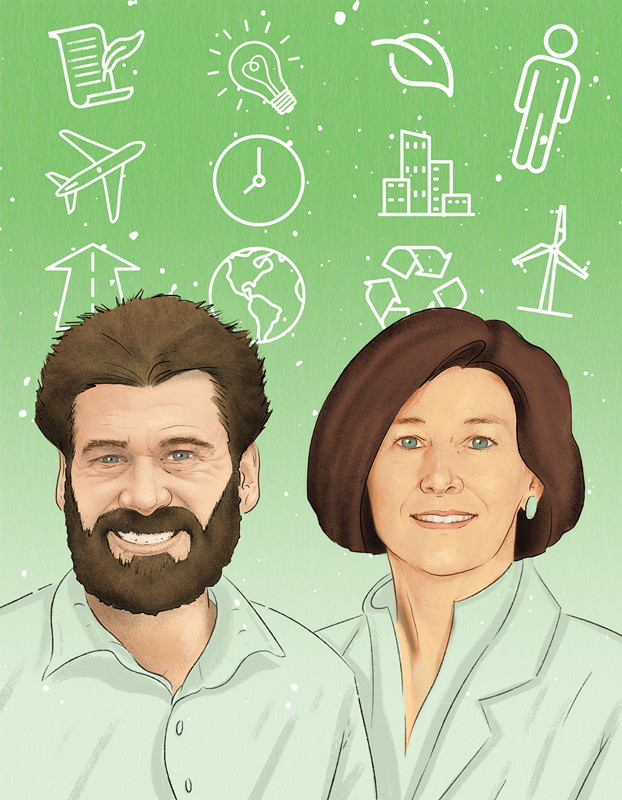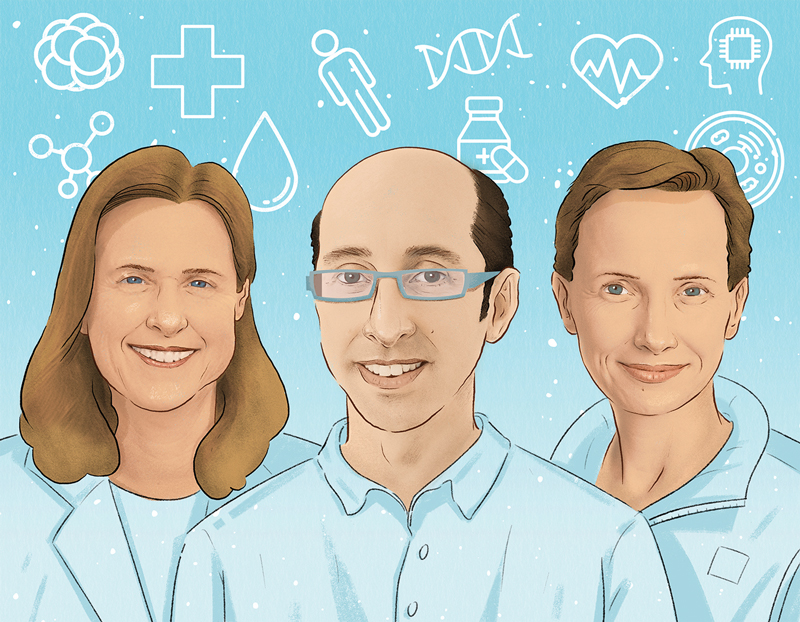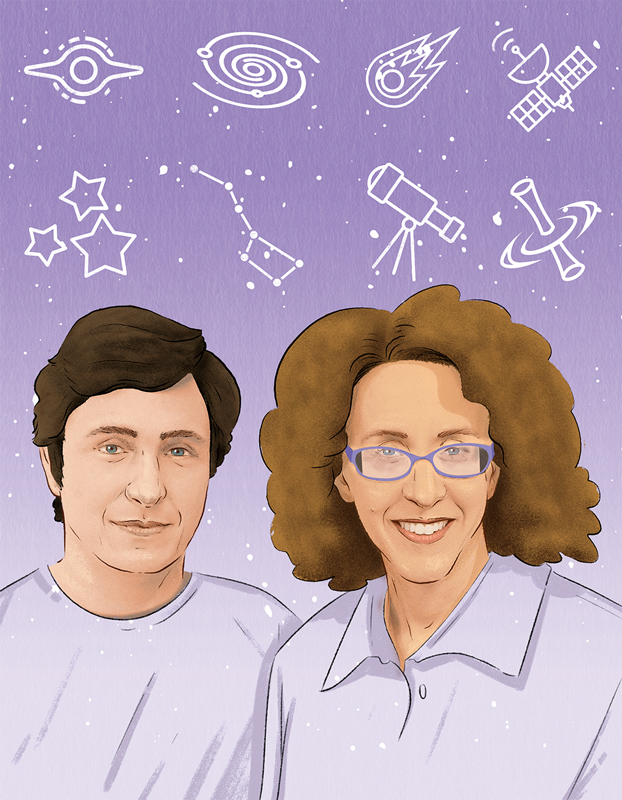CIFAR’S NEW PROGRAMS AT A GLANCE
In April 2023, CIFAR unveiled three new programs that were selected from the Global Call for Ideas. These programs embody high-risk, high-reward research challenges — and the future of being human.
The world is at an inflection point. Rapid changes in the environment, technology and threats to human health are exacerbating inequalities and revealing the need to rethink our position as human beings and global citizens.
Three new CIFAR research programs, and their new program directors, are poised to answer big, bold questions on the future of being human. By exploring environmental, sociological and philosophical factors, among others, these researchers are seeking solutions to the world’s emerging challenges.
FUTURE FLOURISHING

RESEARCH CO-DIRECTORS:
TAREK ELHAIK, UC Davis, United States
CHRISTOPHER KELTY, UCLA, United States
HÉLÈNE MIALET, York University, Canada
Human exceptionalism, the idea that humans are unique from all other organisms and separate from their environment, has dominated Western thought. But today, it is an increasingly critiqued idea.
Researchers in CIFAR’s new Future Flourishing program are asking: “What does it mean to live (well) without human exceptionalism?”
It’s a timely question. "The world’s increasing instability — in politics, nature, and economics — is due in part to the 'fiction' of human exceptionalism", says Hélène Mialet. “The future of being human takes into account the multiple relationships with humans or non-humans that make us who we are.”
The program — envisioned by the co-directors as an innovative challenge to current debates in Science and Technology Studies (STS), political ecology, animal studies, feminist science studies, environmental humanities and contemporary arts — will look at the world holistically to redefine what it means to be human.
“The world’s increasing instability — in politics, nature, and economics — is due in part to the “fiction” of human exceptionalism.”
The program will assemble a highly interdisciplinary network of scholars and practitioners, from philosophers, historians and curators to conservators, artists and anthropologists.
“This will give us an ideal environment to pose new questions and generate new solutions that might not fit well with established domains or disciplines, perhaps even demand-ing their redefinition, or the creation of others,” says Mialet.
New methodologies are also needed to understand the relationships between humans and those on whom we depend to live. “The power of the imagination is key to our endeavour and we will use it in bold, and often unexpected ways,” says Tarek Elhaik.
Research achievements within this program would be profound, says Christopher Kelty, “in how we approach other creatures, how we define our own happiness and success, how we repair what’s been damaged and flourish in the future.” Perhaps even, “escape from certain traps of thought about what it means to be human.”
HUMANITY’S URBAN FUTURE

RESEARCH CO-DIRECTORS:
DIANE DAVIS, Harvard University, United States
SIMON GOLDHILL, Cambridge University, United Kingdom
What makes a good city of the future?
Members of CIFAR’s new Humanity’s Urban Future program are studying what a liveable, adaptable urban environment should look like. Their research will consider many important factors, including infrastructure (both material and institutional), political divisions, questions of scale, climate change, and other potential crises on the horizon.
“How do you plan a city when you know that any city will outgrow its plan, and quickly?” asks Simon Goldhill.
In seeking answers, the program will examine six cities: Calcutta, India; Kinshasa, Democratic Republic of the Congo; Naples, Italy; Mexico City, Mexico; Shanghai, China; and Toronto, Canada.
“How do you plan a city when you know that any city will outgrow its plan, and quickly?”
Despite the cities’ different histories, cultures and geographies, they “generally face similar existential challenges and they tend to persist, grow and change,” says Diane Davis, who adds that they plan to hold program meetings at each location over the next few years to conduct first-hand research.
The goal is to start a larger conversation around policy, innovation and infrastructure, inspiring collective deliberation and learning around how we should prepare for the future, she adds. “We hope that our work will change how cities are imagined — and how humanity’s urban future can be best shaped,” says Goldhill.
THE MULTISCALE HUMAN

RESEARCH CO-DIRECTORS:
GARY BADER, University of Toronto, Canada
KATY BÖRNER, Indiana University, United States
SARAH TEICHMANN, Wellcome Sanger Institute & Cambridge University, United Kingdom
Imagine a “Google Maps” for the human body. From mapping individual mole-cules to an entire person, across populations and time, researchers from CIFAR’s new Multiscale Human program seek to create a universal encyclopedia of the human body, which would transform biomedical research and practice.
“The fundamental knowledge we discover about the human body, coupled with our new experimental and computational methods for multiscale analysis, promises to spur a revolution in medicine,” says Sarah Teichmann. Despite knowing that a mutation at the DNA level can affect all levels of the body’s systems, we have little understanding of these effects and how they relate to each other.
“Learning how this works would enable us to predict the effects of genetic and environmental perturba-tions and how to control them,” explains Gary Bader.
Such an ambitious project faces many challenges — how does one combine data across modalities, spatial and temporal scales and accurately represent the diversity of the human population? An interdisciplinary approach is key. The team also sees opportunities in machine learning.
“The fundamental knowledge we discover about the human body, coupled with our new experimental and computational methods for multiscale analysis, promises to spur a revolution in medicine.”
“Mapping the human body at multiple scales is a marvelous challenge that will require both human and machine intelligence,” says Katy Börner.
The interdisciplinarity and extended time period is one of the major draws for these researchers. “The opportunity to work face-to-face over an extended time period is fantastic, and one you simply wouldn’t get with other sources of fund-ing,” says Teichmann when reflecting on being chosen as part of the CIFAR Global Call for Ideas.
What could a definitive tool like this mean for the future of being human? Börner imagines a future with a “Digital Twin” program that is initiated at birth, and used to predict ideal fitness, nutrition and medical treatments for the real-life human.
“Working towards this self-under-standing will help us solve some of the most pressing challenges we face in improving our health and reducing human suffering,” says Bader.
While the program has many goals and possibilities for discovery, Teichmann adds, “I think many of our biggest discoveries will be entirely unanticipated.”
GRAVITY & THE EXTREME UNIVERSE

RESEARCH CO-DIRECTORS
VICTORIA KASPI, McGill University, Canada
LUIS LEHNER, Perimeter Institute, Canada
In 1986, CIFAR launched its Gravity & the Extreme Universe program to uncover the mysteries of the cosmos. After more than 30 years, the program has been renewed for its final term.
One new exciting area of research for the team is time-domain astronomy, which studies highly variable sources on short time scales — things that are there one moment, and gone the next.
Program co-directors Victoria Kaspi and Luis Lehner say the research promises to be highly fruitful, “particularly given upcoming groundbreaking instrumentation projects that will be coming online,” which will enable unparalleled insights into the cosmos.
These instruments include the upgraded Advanced LIGO/Virgo gravitational wave detectors, as well as the Canadian Hydrogen Intensity Mapping Experiment (CHIME) Fast Radio Burst (FRB) Outrigger telescopes. Both projects include many program members at the helm.
The CHIME/FRB project in particular has been one of the most exciting projects to come out of the program, says Kaspi. The team behind CHIME/FRB is sifting through the sounds of space, leading to unprecedented insights into astronomy’s greatest mysteries: understanding the origins of fast radio bursts. Kaspi hopes the next big discovery will be just as revolutionary — using the gravitational wave detector to constrain the equation of density of neutron-star matter.
Related Articles
-
Bugs, Babies & Brains
June 13, 2024
-
How do we create a google map of the human body?
June 13, 2024
-
How does the brain give rise to the mind?
June 13, 2024
-
A day with Kristin Andrews
June 13, 2024